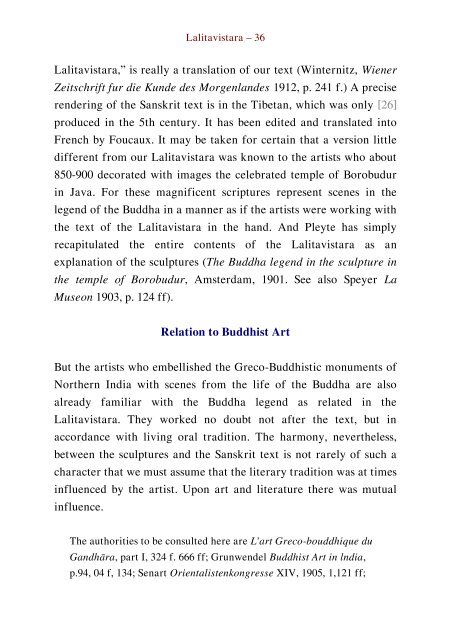Literary History of Sanskrit Buddhism
A study by J. K. Nariman of Sanskrit Buddhism from the Early Buddhist Tradition up to the Mahayana texts proper.
A study by J. K. Nariman of Sanskrit Buddhism from the Early Buddhist Tradition up to the Mahayana texts proper.
Create successful ePaper yourself
Turn your PDF publications into a flip-book with our unique Google optimized e-Paper software.
Lalitavistara – 36<br />
Lalitavistara,” is really a translation <strong>of</strong> our text (Winternitz, Wiener<br />
Zeitschrift fur die Kunde des Morgenlandes 1912, p. 241 f.) A precise<br />
rendering <strong>of</strong> the <strong>Sanskrit</strong> text is in the Tibetan, which was only [26]<br />
produced in the 5th century. It has been edited and translated into<br />
French by Foucaux. It may be taken for certain that a version little<br />
different from our Lalitavistara was known to the artists who about<br />
850-900 decorated with images the celebrated temple <strong>of</strong> Borobudur<br />
in Java. For these magnificent scriptures represent scenes in the<br />
legend <strong>of</strong> the Buddha in a manner as if the artists were working with<br />
the text <strong>of</strong> the Lalitavistara in the hand. And Pleyte has simply<br />
recapitulated the entire contents <strong>of</strong> the Lalitavistara as an<br />
explanation <strong>of</strong> the sculptures (The Buddha legend in the sculpture in<br />
the temple <strong>of</strong> Borobudur, Amsterdam, 1901. See also Speyer La<br />
Museon 1903, p. 124 ff).<br />
Relation to Buddhist Art<br />
But the artists who embellished the Greco-Buddhistic monuments <strong>of</strong><br />
Northern India with scenes from the life <strong>of</strong> the Buddha are also<br />
already familiar with the Buddha legend as related in the<br />
Lalitavistara. They worked no doubt not after the text, but in<br />
accordance with living oral tradition. The harmony, nevertheless,<br />
between the sculptures and the <strong>Sanskrit</strong> text is not rarely <strong>of</strong> such a<br />
character that we must assume that the literary tradition was at times<br />
influenced by the artist. Upon art and literature there was mutual<br />
influence.<br />
The authorities to be consulted here are L’art Greco-bouddhique du<br />
Gandhāra, part I, 324 f. 666 ff; Grunwendel Buddhist Art in lndia,<br />
p.94, 04 f, 134; Senart Orientalistenkongresse XIV, 1905, 1,121 ff;


















